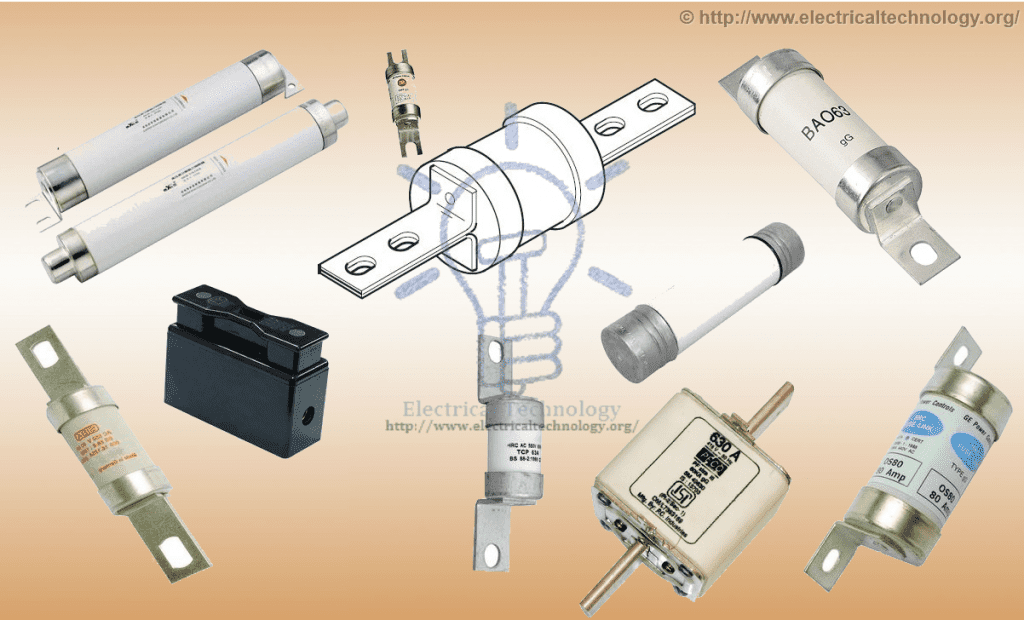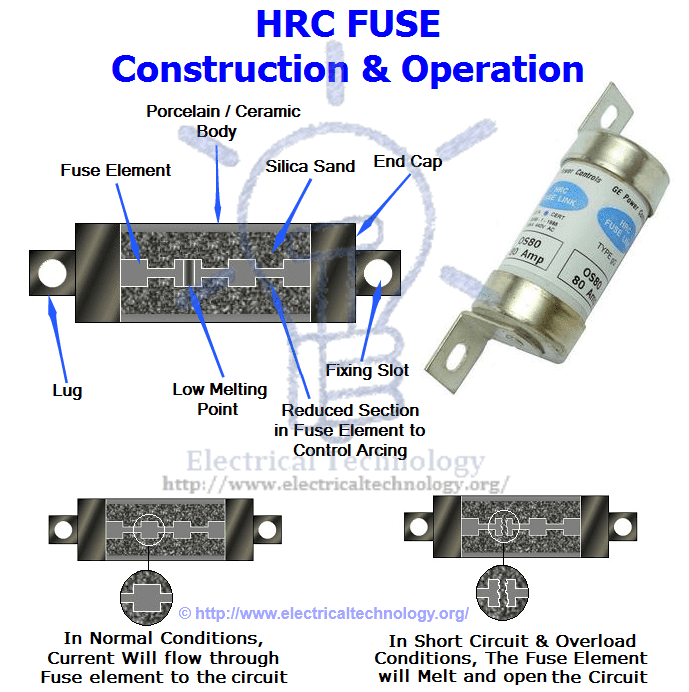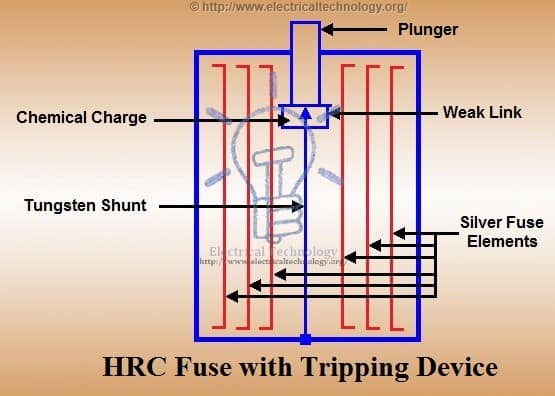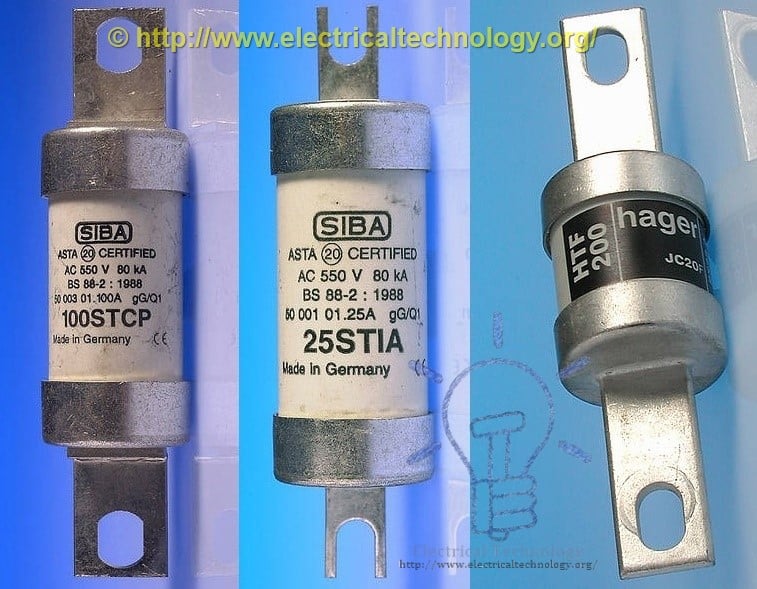HRC Fuse (High Rupturing Capacity Fuse) and its Types
This type of fuse contains a fuse wire in it, which carries the short circuit current safely for a given time period. During this period, if fault is removed, then it does not blow off otherwise it will melt and remove the circuit from electrical supply hence, the circuit remains safe.
The common material, which is used to make an HRC fuse is glass, but this is not always the case. Other chemical compounds are also used in HRC fuse manufacturing and construction based on different factors. Its external enclosure is made fully airtight in order to avoid the effect of atmosphere on the fuse materials. The major objection on HRC fuse is low and uncertain breaking capacity of semi-enclosed fuse.
Construction and Operations of HRC fuse
HRC Fuse consists of highly heat resistant material (such as ceramic) body having metal-end caps, which is welded by silver current carrying element. The fuse body internal space is completely packed with a filling powder. The material, which has filled the insider space, may be plaster of Paris, quartz, chalk, marble, dust and cooling mediums etc. That’s why it carries normal current without overheating. The heat being produced vaporizes the silver melted element. Chemical reaction taking place between silver vapor and filling powder results in high resistance substance, which helps in quenching the arc in fuse.
Advantages of HRC Fuse
- It clears high as well as low fault currents.
- Do not deteriorate with age.
- Having high-speed operation.
- Provides reliable discrimination.
- Require no maintenance.
- Cheaper than other circuit interrupting devices with same rating.
- Permit consistent performance
- Fusing operation is fast without Noise and Smoke
Disadvantages of H.R.C Fuse
- After each operation, they have to be replaced.
- Heat being produced by the arc may affect the associated switches.
HRC Fuse with Tripping Device
When a fuse blows out the tripping device during the fault condition, it will cause the circuit breaker to operate. The body of fuse is made of ceramic material with a metallic cap fixed at each end. They are connected by series of silver fuse elements. There is a plunger at one end, which hits the tripping mechanism of circuit breaker under fault conditions, which leads it to operate the circuit. The plunger is connected through a fusible link and a tungsten wire to the other end of the cap.
As fault occurs, the first element to be blown out is silver fuse and current is transferred to tungsten wire. The travel of the plunger is set such a way that is not ejected from the fuse body during fault conditions.
Advantages of HRC Fuse with Tripping Device:
- During single-phase fault on a three-phase system, the plunger trips the circuit breaker, which opens all the three phases, i.e. it prevents single-phase supply as well.
- The effects of the short circuit need to be considered in circuit breaker, which allow the use of an inexpensive circuit breaker.
- The fuse-tripped breaker is capable of dealing with small currents, which avoids the necessity of replacing the fuse (except high current).
Low voltage H.R.C fuses are also available in a capacity of 16000A to 30,000A at 400V (Also available in range of 80kA to 120kA) . HRC Fuses are also used for protection on low voltage distribution systems against overload and short circuit conditions.
Types of HRC fuse:
NH Type H.R.C Fuse:
NH fuse provides overload and short circuit protection for low and medium voltage. They provide backup protection to motor starters and other equipment against short circuit and overload. They are light in weight with compact dimension.
Din Type HRC Fuse:
Din type fuses are available in wide range of rated currents. DIN fuse are used for different purposes with their characteristic at different temperature condition. They types of fuses are available for different voltages level and can be used in transformer protection even where there is no LV (Low-Voltage) Secondary or backup protection. They have excellent clearing capability of ideal low over current with short-circuit performance. Other uses and application of DIN fuses are in air and gas insulated switchgear, mining, transformers and Feeder sectionalizing.
Blade Type HRC fuse:
This type of fuses (also known as spade or plug-in fuses) comes in plastic body and two metal caps to fit in the socket. Mostly, they used in automobiles for wiring and short circuit protection. They are light in weight. It contains low cutoff current. They are also used for short circuit and backup protection of motors. They are available in different sizes and shapes with different current rating capacity, which print on the top.
Application of H.R.C fuses:
- Used for protection of Transformers, Motors and automobile, etc.
- It is also used in motor stators
- Backup protection
Few words:
After reviewing the advantages and disadvantages of H.R.C fuses for low voltage installation, which can be easily replaced. They provide high-speed operation in short circuit and over current protection. They also provide stability in industrial power distribution and semiconductor protection. Both fuse and circuit breaker complement each other in a low voltage system. They can be used to provide backup protection to the circuit breaker with high breaking capacity.






